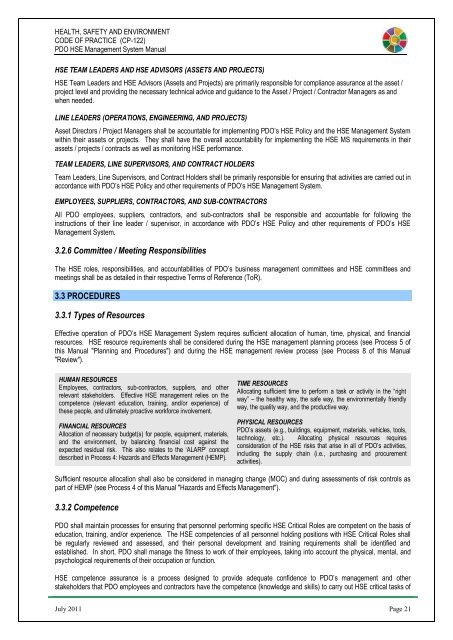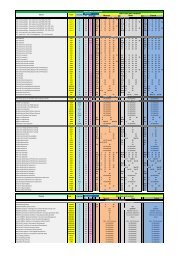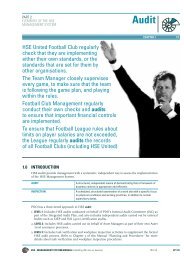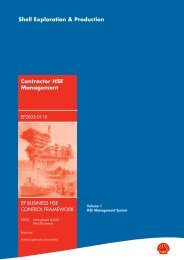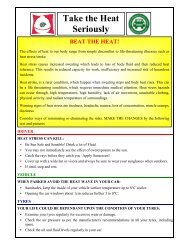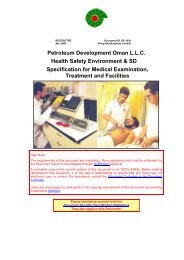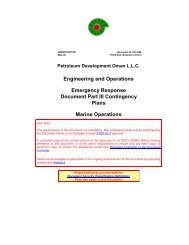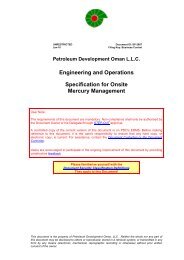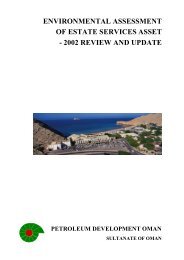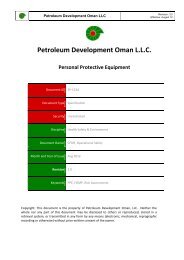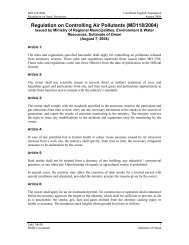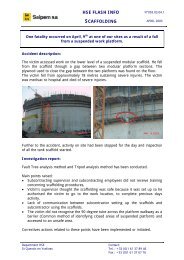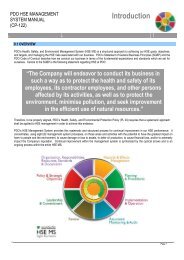CP-122 HSE Code of Practice - PDO
CP-122 HSE Code of Practice - PDO
CP-122 HSE Code of Practice - PDO
Create successful ePaper yourself
Turn your PDF publications into a flip-book with our unique Google optimized e-Paper software.
HEALTH, SAFETY AND ENVIRONMENT<br />
CODE OF PRACTICE (<strong>CP</strong>-<strong>122</strong>)<br />
<strong>PDO</strong> <strong>HSE</strong> Management System Manual<br />
<strong>HSE</strong> TEAM LEADERS AND <strong>HSE</strong> ADVISORS (ASSETS AND PROJECTS)<br />
<strong>HSE</strong> Team Leaders and <strong>HSE</strong> Advisors (Assets and Projects) are primarily responsible for compliance assurance at the asset /<br />
project level and providing the necessary technical advice and guidance to the Asset / Project / Contractor Managers as and<br />
when needed.<br />
LINE LEADERS (OPERATIONS, ENGINEERING, AND PROJECTS)<br />
Asset Directors / Project Managers shall be accountable for implementing <strong>PDO</strong>‟s <strong>HSE</strong> Policy and the <strong>HSE</strong> Management System<br />
within their assets or projects. They shall have the overall accountability for implementing the <strong>HSE</strong> MS requirements in their<br />
assets / projects / contracts as well as monitoring <strong>HSE</strong> performance.<br />
TEAM LEADERS, LINE SUPERVISORS, AND CONTRACT HOLDERS<br />
Team Leaders, Line Supervisors, and Contract Holders shall be primarily responsible for ensuring that activities are carried out in<br />
accordance with <strong>PDO</strong>‟s <strong>HSE</strong> Policy and other requirements <strong>of</strong> <strong>PDO</strong>‟s <strong>HSE</strong> Management System.<br />
EMPLOYEES, SUPPLIERS, CONTRACTORS, AND SUB-CONTRACTORS<br />
All <strong>PDO</strong> employees, suppliers, contractors, and sub-contractors shall be responsible and accountable for following the<br />
instructions <strong>of</strong> their line leader / supervisor, in accordance with <strong>PDO</strong>‟s <strong>HSE</strong> Policy and other requirements <strong>of</strong> <strong>PDO</strong>‟s <strong>HSE</strong><br />
Management System.<br />
3.2.6 Committee / Meeting Responsibilities<br />
The <strong>HSE</strong> roles, responsibilities, and accountabilities <strong>of</strong> <strong>PDO</strong>‟s business management committees and <strong>HSE</strong> committees and<br />
meetings shall be as detailed in their respective Terms <strong>of</strong> Reference (ToR).<br />
3.3 PROCEDURES<br />
3.3.1 Types <strong>of</strong> Resources<br />
Effective operation <strong>of</strong> <strong>PDO</strong>‟s <strong>HSE</strong> Management System requires sufficient allocation <strong>of</strong> human, time, physical, and financial<br />
resources. <strong>HSE</strong> resource requirements shall be considered during the <strong>HSE</strong> management planning process (see Process 5 <strong>of</strong><br />
this Manual "Planning and Procedures") and during the <strong>HSE</strong> management review process (see Process 8 <strong>of</strong> this Manual<br />
"Review").<br />
HUMAN RESOURCES<br />
Employees, contractors, sub-contractors, suppliers, and other<br />
relevant stakeholders. Effective <strong>HSE</strong> management relies on the<br />
competence (relevant education, training, and/or experience) <strong>of</strong><br />
these people, and ultimately proactive workforce involvement.<br />
FINANCIAL RESOURCES<br />
Allocation <strong>of</strong> necessary budget(s) for people, equipment, materials,<br />
and the environment, by balancing financial cost against the<br />
expected residual risk. This also relates to the „ALARP‟ concept<br />
described in Process 4: Hazards and Effects Management (HEMP).<br />
TIME RESOURCES<br />
Allocating sufficient time to perform a task or activity in the “right<br />
way” – the healthy way, the safe way, the environmentally friendly<br />
way, the quality way, and the productive way.<br />
PHYSICAL RESOURCES<br />
<strong>PDO</strong>‟s assets (e.g., buildings, equipment, materials, vehicles, tools,<br />
technology, etc.). Allocating physical resources requires<br />
consideration <strong>of</strong> the <strong>HSE</strong> risks that arise in all <strong>of</strong> <strong>PDO</strong>‟s activities,<br />
including the supply chain (i.e., purchasing and procurement<br />
activities).<br />
Sufficient resource allocation shall also be considered in managing change (MOC) and during assessments <strong>of</strong> risk controls as<br />
part <strong>of</strong> HEMP (see Process 4 <strong>of</strong> this Manual "Hazards and Effects Management").<br />
3.3.2 Competence<br />
<strong>PDO</strong> shall maintain processes for ensuring that personnel performing specific <strong>HSE</strong> Critical Roles are competent on the basis <strong>of</strong><br />
education, training, and/or experience. The <strong>HSE</strong> competencies <strong>of</strong> all personnel holding positions with <strong>HSE</strong> Critical Roles shall<br />
be regularly reviewed and assessed, and their personal development and training requirements shall be identified and<br />
established. In short, <strong>PDO</strong> shall manage the fitness to work <strong>of</strong> their employees, taking into account the physical, mental, and<br />
psychological requirements <strong>of</strong> their occupation or function.<br />
<strong>HSE</strong> competence assurance is a process designed to provide adequate confidence to <strong>PDO</strong>‟s management and other<br />
stakeholders that <strong>PDO</strong> employees and contractors have the competence (knowledge and skills) to carry out <strong>HSE</strong> critical tasks <strong>of</strong><br />
July 2011 Page 21


